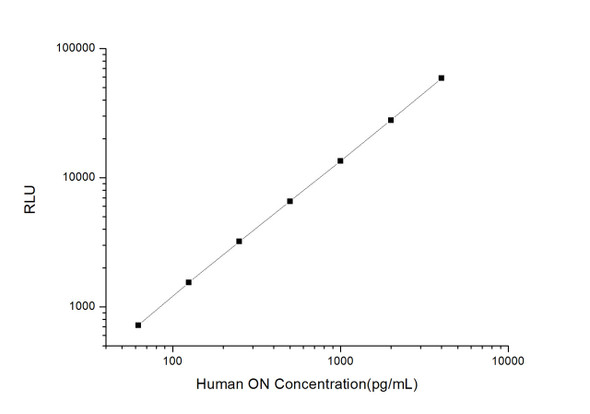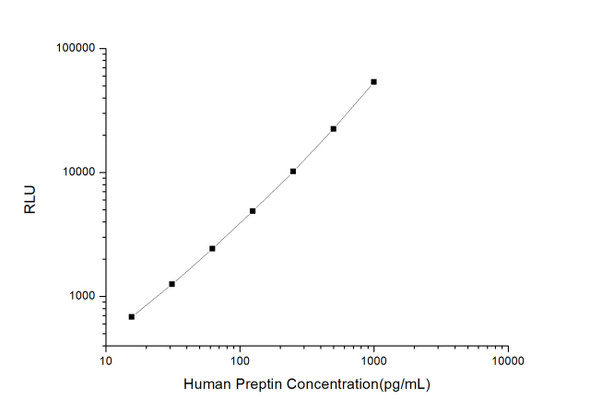Human Cell Biology ELISA Kits 5
Human DSP (Desmoplakin) CLIA Kit (HUES01023)
- SKU:
- HUES01023
- Product Type:
- ELISA Kit
- ELISA Type:
- CLIA Kit
- Size:
- 96 Assays
- Sensitivity:
- 37.5pg/mL
- Range:
- 62.5-4000pg/mL
- ELISA Type:
- Sandwich
- Synonyms:
- DP, DPI, DPII
- Reactivity:
- Human
- Sample Type:
- Serum, plasma and other biological fluids
- Research Area:
- Cell Biology
Description
| Assay type: | Sandwich |
| Format: | 96T |
| Assay time: | 4.5h |
| Reactivity: | Human |
| Detection method: | Chemiluminescence |
| Detection range: | 62.50-4000 pg/mL |
| Sensitivity: | 37.50 pg/mL |
| Sample volume: | 100µL |
| Sample type: | Serum, plasma and other biological fluids |
| Repeatability: | CV < 15% |
| Specificity: | This kit recognizes Human DSP in samples. No significant cross-reactivity or interference between Human DSP and analogues was observed. |
This kit uses Sandwich-CLIA as the method. The micro CLIA plate provided in this kit has been pre-coated with an antibody specific to Human DSP. Standards or samples are added to the appropriate micro CLIA plate wells and combined with the specific antibody. Then a biotinylated detection antibody specific for Human DSP and Avidin-Horseradish Peroxidase (HRP) conjugate are added to each micro plate well successively and incubated. Free components are washed away. The substrate solution is added to each well. Only those wells that contain Human DSP, biotinylated detection antibody and Avidin-HRP conjugate will appear fluorescence. The Relative light unit (RLU) value is measured spectrophotometrically by the Chemiluminescence immunoassay analyzer. The RLU value is positively associated with the concentration of Human DSP. The concentration of Human DSP in the samples can be calculated by comparing the RLU of the samples to the standard curve.
| UniProt Protein Function: | Desmoplakin: Major high molecular weight protein of desmosomes. Involved in the organization of the desmosomal cadherin- plakoglobin complexes into discrete plasma membrane domains and in the anchoring of intermediate filaments to the desmosomes. Homodimer. Interacts with COL17A1 (via cytoplasmic region). Associates (via C-terminal) with KRT5-KRT14 (via rod region), KRT8-KRT18 and VIM intermediate filaments. Interacts with DSC2. Isoform DPI is apparently an obligate constituent of all desmosomes. Isoform DPII resides predominantly in tissues and cells of stratified origin. Belongs to the plakin or cytolinker family. 2 isoforms of the human protein are produced by alternative splicing. |
| UniProt Protein Details: | Protein type:Motility/polarity/chemotaxis; Cytoskeletal; Cell adhesion Chromosomal Location of Human Ortholog: 6p24 Cellular Component: desmosome; mitochondrion; basolateral plasma membrane; plasma membrane; intermediate filament; cornified envelope; fascia adherens; nucleus Molecular Function:protein binding, bridging; protein binding; protein kinase C binding; structural constituent of cytoskeleton; cell adhesion molecule binding; structural molecule activity Biological Process: keratinocyte differentiation; cell-cell adhesion; epidermis development; wound healing; apoptosis; intermediate filament organization; peptide cross-linking; cell structure disassembly during apoptosis Disease: Cardiomyopathy, Dilated, With Woolly Hair And Keratoderma; Arrhythmogenic Right Ventricular Dysplasia, Familial, 8; Keratosis Palmoplantaris Striata Ii; Cardiomyopathy, Dilated, With Woolly Hair, Keratoderma, And Tooth Agenesis; Skin Fragility-woolly Hair Syndrome; Epidermolysis Bullosa, Lethal Acantholytic |
| NCBI Summary: | Desmosomes are intercellular junctions that tightly link adjacent cells. Desmoplakin is an obligate component of functional desmosomes that anchors intermediate filaments to desmosomal plaques. The N-terminus of desmoplakin is required for localization to the desmosome and interacts with the N-terminal region of plakophilin 1 and plakoglobin. The C-terminus of desmoplakin binds with intermediate filaments. In the mid-region of desmoplakin, a coiled-coiled rod domain is responsible for homodimerization. Mutations in this gene are the cause of several cardiomyopathies and keratodermas as well as the autoimmune disease paraneoplastic pemphigus. [provided by RefSeq, Jul 2008] |
| UniProt Code: | P15924 |
| NCBI GenInfo Identifier: | 58530840 |
| NCBI Gene ID: | 1832 |
| NCBI Accession: | NP_004406. 2 |
| UniProt Secondary Accession: | P15924,O75993, Q14189, Q9UHN4, B2RTT2, D7RX09, |
| UniProt Related Accession: | P15924 |
| Molecular Weight: | 278,916 Da |
| NCBI Full Name: | desmoplakin isoform I |
| NCBI Synonym Full Names: | desmoplakin |
| NCBI Official Symbol: | DSP |
| NCBI Official Synonym Symbols: | DP; DPI; DPII; DCWHKTA |
| NCBI Protein Information: | desmoplakin |
| UniProt Protein Name: | Desmoplakin |
| UniProt Synonym Protein Names: | 250/210 kDa paraneoplastic pemphigus antigen |
| Protein Family: | Desmoplakin |
| UniProt Gene Name: | DSP |
| UniProt Entry Name: | DESP_HUMAN |
As the RLU values of the standard curve may vary according to the conditions of the actual assay performance (e. g. operator, pipetting technique, washing technique or temperature effects), the operator should establish a standard curve for each test. Typical standard curve and data is provided below for reference only.
| Concentration (pg/mL) | RLU | Average | Corrected |
| 4000 | 57168 60994 | 59081 | 59046 |
| 2000 | 27663 28055 | 27859 | 27824 |
| 1000 | 14181 12787 | 13484 | 13449 |
| 500 | 6398 6812 | 6605 | 6570 |
| 250 | 3302 3184 | 3243 | 3208 |
| 125 | 1646 1516 | 1581 | 1546 |
| 62.50 | 732 778 | 755 | 720 |
| 0 | 34 36 | 35 | -- |
Precision
Intra-assay Precision (Precision within an assay): 3 samples with low, mid range and high level Human DSP were tested 20 times on one plate, respectively.
Inter-assay Precision (Precision between assays): 3 samples with low, mid range and high level Human DSP were tested on 3 different plates, 20 replicates in each plate.
| Intra-assay Precision | Inter-assay Precision | |||||
| Sample | 1 | 2 | 3 | 1 | 2 | 3 |
| n | 20 | 20 | 20 | 20 | 20 | 20 |
| Mean (pg/mL) | 209.51 | 451.06 | 1463.48 | 203.95 | 469.60 | 1495.10 |
| Standard deviation | 25.14 | 40.78 | 140.35 | 19.80 | 42.50 | 98.68 |
| C V (%) | 12.00 | 9.04 | 9.59 | 9.71 | 9.05 | 6.60 |
Recovery
The recovery of Human DSP spiked at three different levels in samples throughout the range of the assay was evaluated in various matrices.
| Sample Type | Range (%) | Average Recovery (%) |
| Serum (n=5) | 93-104 | 98 |
| EDTA plasma (n=5) | 93-107 | 101 |
| Cell culture media (n=5) | 98-113 | 105 |
Linearity
Samples were spiked with high concentrations of Human DSP and diluted with Reference Standard & Sample Diluent to produce samples with values within the range of the assay.
| Serum (n=5) | EDTA plasma (n=5) | Cell culture media (n=5) | ||
| 1:2 | Range (%) | 88-102 | 94-111 | 93-108 |
| Average (%) | 94 | 101 | 99 | |
| 1:4 | Range (%) | 101-116 | 98-113 | 85-97 |
| Average (%) | 107 | 104 | 90 | |
| 1:8 | Range (%) | 96-113 | 90-104 | 96-114 |
| Average (%) | 103 | 97 | 104 | |
| 1:16 | Range (%) | 92-107 | 96-110 | 92-110 |
| Average (%) | 99 | 103 | 100 |
An unopened kit can be stored at 4°C for 1 month. If the kit is not used within 1 month, store the items separately according to the following conditions once the kit is received.
| Item | Specifications | Storage |
| Micro CLIA Plate(Dismountable) | 8 wells ×12 strips | -20°C, 6 months |
| Reference Standard | 2 vials | |
| Concentrated Biotinylated Detection Ab (100×) | 1 vial, 120 µL | |
| Concentrated HRP Conjugate (100×) | 1 vial, 120 µL | -20°C(shading light), 6 months |
| Reference Standard & Sample Diluent | 1 vial, 20 mL | 4°C, 6 months |
| Biotinylated Detection Ab Diluent | 1 vial, 14 mL | |
| HRP Conjugate Diluent | 1 vial, 14 mL | |
| Concentrated Wash Buffer (25×) | 1 vial, 30 mL | |
| Substrate Reagent A | 1 vial, 5 mL | 4°C (shading light) |
| Substrate Reagent B | 1 vial, 5 mL | 4°C (shading light) |
| Plate Sealer | 5 pieces | |
| Product Description | 1 copy | |
| Certificate of Analysis | 1 copy |
- Set standard, test sample and control (zero) wells on the pre-coated plate and record theirpositions. It is recommended to measure each standard and sample in duplicate. Note: addall solutions to the bottom of the plate wells while avoiding contact with the well walls. Ensuresolutions do not foam when adding to the wells.
- Aliquot 100 µL of standard solutions into the standard wells.
- Add 100 µL of Sample / Standard dilution buffer into the control (zero) well.
- Add 100 µL of properly diluted sample (serum, plasma, tissue homogenates and otherbiological fluids. ) into test sample wells.
- Cover the plate with the sealer provided in the kit and incubate for 90 min at 37 °C.
- Aspirate the liquid from each well, do not wash. Immediately add 100 µL of BiotinylatedDetection Ab working solution to each well. Cover the plate with a plate seal and gently mix. Incubate for 1 hour at 37 °C.
- Aspirate or decant the solution from the plate and add 350 µL of wash buffer to each welland incubate for 1-2 minutes at room temperature. Aspirate the solution from each well andclap the plate on absorbent filter paper to dry. Repeat this process 3 times. Note: a microplatewasher can be used in this step and other wash steps.
- Add 100 µL of HRP Conjugate working solution to each well. Cover with a plate seal andincubate for 30 min at 37 °C.
- Aspirate or decant the solution from each well. Repeat the wash process for five times asconducted in step 7.
- Add 100 µL of Substrate mixture solution to each well. Cover with a new plate seal andincubate for no more than 5 min at 37 °C. Protect the plate from light.
- Determine the RLU value of each well immediately.






